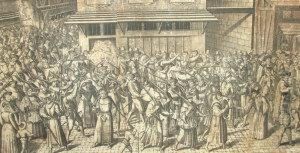Jean-Jacques Perrissin Paintings
Jean-Jacques Perrissin was a French artist, primarily known as an engraver and printmaker, born in 1536 in Lyon, France. Although not as widely recognized as some of his contemporaries, Perrissin played a significant role in the development of printmaking during the 16th century, a period that experienced a flourishing of graphic arts due to the increasing availability of paper and the growing demand for prints for both educational and decorative purposes.
Perrissin's life and work were emblematic of the Renaissance period, which saw an explosion of interest in the arts, science, and the human form. He was active during an era that was defined by religious upheaval and the Protestant Reformation, which is reflected in some of his works. He is known to have been a Protestant, which at the time was a significant personal and professional stance, as it often influenced both the subject matter of artists' works and their patronage.
As an artist, Perrissin was particularly accomplished in creating detailed and intricate engravings. Though the specifics of his training are not well-documented, it is likely that he apprenticed with a master engraver and learned the trade of woodcutting and metal engraving, which were the primary methods of producing prints at the time. Perrissin's works often depicted religious scenes, allegories, and events from the French Wars of Religion. His style was characterized by a strong narrative element, with attention to detail and an effort to convey a story through visual means.
One of his most notable works is a series of forty prints illustrating the Huguenot iconography, created in collaboration with the writer Guillaume de la Place. This series, known as 'Quarante Tableaux ou Histoires Diverses qui sont Mémorables touchant les Guerres, Massacres et Troubles advenus en France en ces dernières Années,' was published around 1570 and depicted various episodes of the French Wars of Religion from a Protestant perspective. The series is significant for its historical value and as an example of Reformation-era propaganda.
Perrissin's engravings were not only important for their artistic merit but also served as a means of disseminating information and ideas. During his lifetime, he contributed to the growing trend of using prints as a way to communicate news, political ideas, and social commentary to a broader audience that was becoming increasingly literate.
Jean-Jacques Perrissin died in 1618 in Geneva, Switzerland. His works remain a valuable resource for historians and art enthusiasts alike, providing insight into the religious and political landscape of 16th-century France, as well as the technical and stylistic developments in the field of printmaking during the Renaissance.
